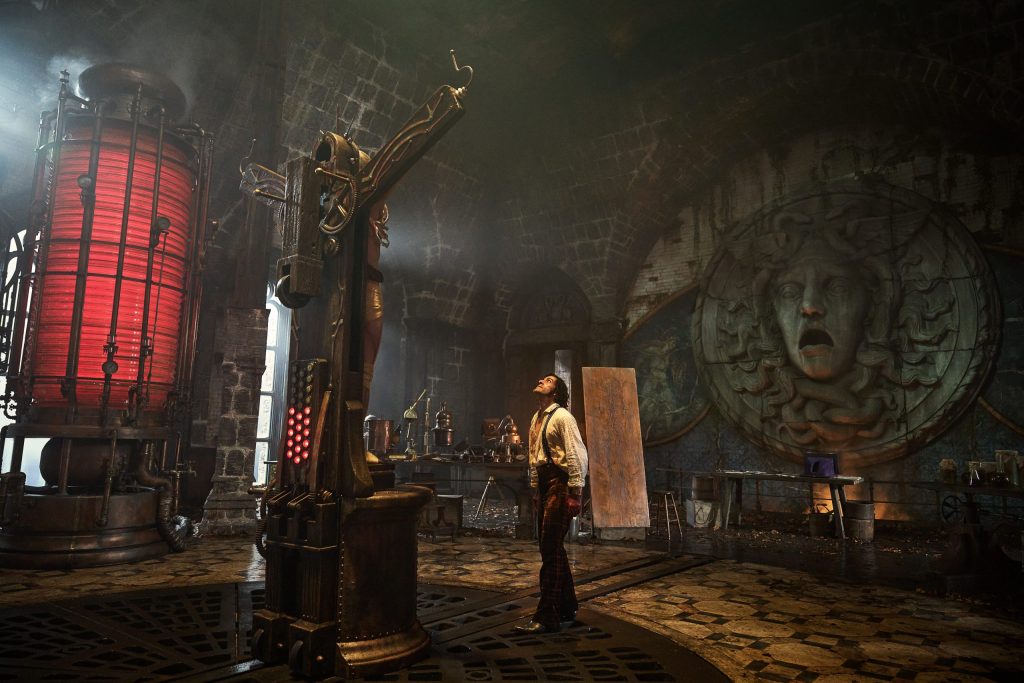
Through his 40 years of filmmaking, Academy Award-winning director Guillermo del Toro has chased the same dream: an adaptation of Mary Shelley’s seminal novel “Frankenstein.” But now that his vision is finally a reality, can it conceivably live up to the hype?
With the backing of Netflix, del Toro has authored a vast, expensive, and beautiful rendition of a story with which the director possesses an obsession he himself has referred to as “unhealthy.” His “Frankenstein” is an impressive and entertaining film, no doubt, but one that also feels perfunctory to a fault.
This adaptation is neatly arranged into non-linear thirds. “Prelude” begins near the end, with The Creature (Jacob Elordi) chasing his creator, Victor Frankenstein (Oscar Isaac) through the Arctic. Victor, holed up on a ship trapped in the ice, tells his story to the captain, making the prologue a framing sequence. Then, “Act I” follows Victor’s life from childhood to the creation and “birth” of The Creature. The lengthiest passage in the film, it climaxes when Victor realizes he is unprepared for what comes after reanimating a person stitched from the limbs of the dead, having no concept of how to teach, nurture, or love it.
“Act II” sees The Creature infiltrating Victor’s hiding place on the boat, and this hulking, horrifying mass of preternatural strength gets to tell his side of the story, picking up from when he was left for dead, tracking all the way to the present.
It is a robust film at 150 minutes. Its curious structure lends itself to some issues with pace, but the world is so dazzlingly realized that the viewer remains in its thrall even during the pockets where a less ardent admirer of the story might have more brutally pruned the runtime. Whether it is a faithful adaptation of the novel is beside the point; it is less the bringing of a book to life as it is stepping into a long procession of “Victors” Frankenstein who have already transformed the text into screen magic, honoring all that the book has borne in the last 200 years.
Since its publication in 1818, there have been innumerable adaptations across various mediums, each in its own way building upon the source material in ways that become inextricable from the myth the original story spawned. James Whale’s 1931 “Frankenstein” film for Universal is perhaps the most iconic, and clearly del Toro’s most foundational influence. The tragic performance Boris Karloff delivered as The Monster is a portrait echoed throughout del Toro’s entire filmography, its inspiration present in every “creature feature” he’s ever made.
Whether or not one has seen the film or even read the book, its ideas, themes, and images have seeped so thoroughly into the pop cultural consciousness as to be embedded in one’s bones.
Whether or not one has seen the film or even read the book, its ideas, themes, and images have seeped so thoroughly into the pop cultural consciousness as to be embedded in one’s bones — were the human brain a Windows computer from the ‘90s, the lumbering, green-skinned mass with the bolts on his neck would be “Clippy,” the friendly digital assistant that wanted to help you make an Excel spreadsheet. The central tenet that Victor, the mad scientist, is the “real” monster and that The Creature is merely otherness made flesh, a victim of cruel circumstances beyond his control, appears throughout del Toro’s works. It’s kind of his whole shtick.
“Frankenstein” at times feels like a funhouse walk down memory lane, recapturing elements from del Toro’s prior works. Victor’s brief flirtation with his soon to be sister-in-law Elizabeth (Mia Goth) feels ripped right from “Crimson Peak,” with its sumptuous photography and ornate gothic environs. Moments with The Creature in the woods, learning about nature, call to mind the fairy tale tone of “Pan’s Labyrinth.” Hell, even the fleeting bits of violence when The Creature is little more than rage made manifest have the pugilistic punchiness of the action from “Blade II.”
There are a handful of moments throughout that feel exemplary in their execution, truly exhilarating to behold. The unfinished husk of The Creature, prostrated on a table, collapsed in child pose, bolting upright when a surge of electricity jolts it upright for the briefest of moments. The Creature, alive and cartoonishly tall, kneels at the knee of an old, blind man (David Bradley), who so casually gives him unconditional love that the enormity of his form seems to shrink to that of a calmed child. The central set piece of The Creature’s birth never needs the infamous “It’s alive!” dialogue because the entire sequence is so emphatic and gorgeously realized that it’s like it arrives fully formed from del Toro’s brain.
It is a fascinating mystery to imagine what sort of films [del Toro] will make now that he has gotten this out of his system.
But outside of those brilliant moments, across its two-and-a-half hour runtime, the film feels like a foregone conclusion. For anyone unfamiliar with del Toro’s work, “Frankenstein” is likely a fulfilling experience, as moving as it is entertaining. For anyone who has seen everything else he’s ever made, it feels, unfortunately, like the very drawn-out answer to a question no one asked. It is exactly the film one would expect, with so little surprise and delight that what beauty is on display is reduced by its chockablock construction.
In a 2016 interview, del Toro said “I dream I can make the greatest Frankenstein ever, but then if you make it, you’ve made it. Whether it’s great or not, it’s done. You cannot dream about it anymore.” It is a fascinating mystery to imagine what sort of films he will make now that he has gotten this out of his system. But having seen it realized, it’s difficult not to wonder if it should have stayed in his head forever.
“Frankenstein” is playing theatrically until November 7th, when it moves to exclusive streaming on Netflix.
The post ‘Frankenstein’ is the movie Guillermo del Toro was born to make… appeared first on Baltimore Beat.

